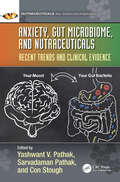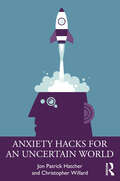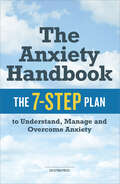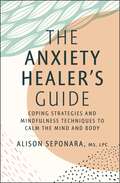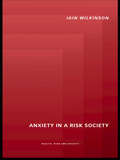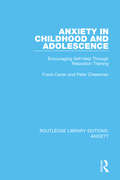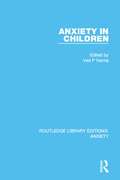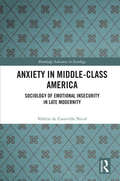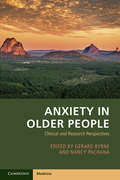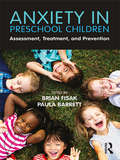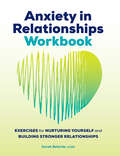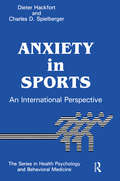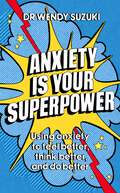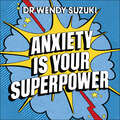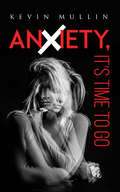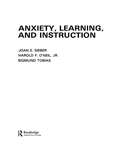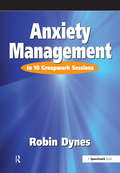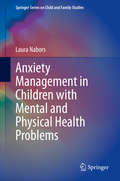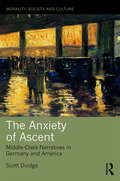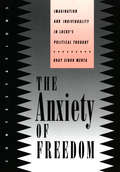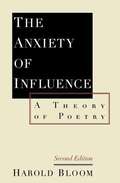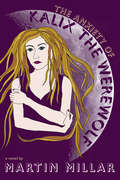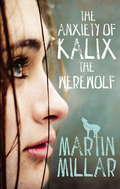- Table View
- List View
Anxiety, Gut Microbiome, and Nutraceuticals: Recent Trends and Clinical Evidence (Nutraceuticals)
by Yashwant V. Pathak, Sarvadaman Pathak, and Con StoughHealthy gut function is associated with normal central nervous system (CNS) function. Hormones, neurotransmitters, and immunological factors released from the gut are known to send signals to the brain either directly or via autonomic neurons. Recently, studies have emerged focusing on variations in the microbiome and the effect on various CNS disorders, including, but not limited to anxiety, depressive disorders, schizophrenia, and autism. Anxiety, Gut Microbiome, and Nutraceuticals: Recent Trends and Clinical Evidence is focused on understanding the role of gut microbiomes on anxiety and how it can be treated using various nutraceuticals. It covers recent trends and clinical evidence in application of nutraceuticals in treating anxiety and related disorders.Key Features Explains various factors related to anxiety and anxiety-related disorders including pathophysiological and pharmacological factors Discusses the pharmacology behind anxiety and related disorders Explores the role of gut microbiota and its relationship with anxiety and related disorders Describes different nutraceuticals and classes of nutraceuticals which can be useful to treat anxiety and related disorders In recent years, there has been an increased interest in nutraceuticals and their applications in treating many diseases and disorders. The market has grown tremendously, and this book focuses on the many clinical studies reporting on the usefulness of nutraceuticals in treating such health conditions.
Anxiety Hacks for an Uncertain World
by Jon Patrick Hatcher Christopher WillardAnxiety Hacks for an Uncertain World is a highly accessible guide to anxiety disorders. It helps anxiety sufferers regain control by suggesting an array of useful tactics which when applied can be life altering. Chapters explore key topics such as phobias, panic disorders, social anxiety, general anxiety, pandemics, and more. Additional resources are included in the appendix, such as support groups, services, and helplines. Using light humor and examples from their lived experiences the authors relate to readers and offer useful suggestions to overcome anxiety and understand it. This book will be essential for anyone suffering from anxiety and phobias or professionals working with this population. It can be used on its own or in conjunction with therapy.
The Anxiety Handbook: The 7-Step Plan to Understand, Manage, and Overcome Anxiety
by Calistoga PressThe Anxiety Handbook The 7-Step Plan to Understand, Manage and Overcome Anxiety Anxiety is one of the number one mental health conditions affecting American adults, and one that many people suffer through alone. Anxiety, stress, and overwhelming negative emotions can get in the way of a fulfilling and rewarding life. But this shouldn't have to be the case. The Anxiety Handbook is your guide to confronting and working through your anxiety, and experiencing calm you never thought possible. Whether you've been diagnosed with an anxiety disorder, or you're simply having trouble managing anxious feelings, you can start controlling your anxiety and feeling better soon. The Anxiety Handbook will help you achieve immediate relief from anxiety, and create a straightforward pathway for long-term change. The Anxiety Handbook is your first step toward overcoming anxiety with: 7 basic steps to help you understand, manage, and overcome your anxiety An overview of the symptoms and causes of anxiety Real-life strategies for coping with daily anxiety-inducing triggers Easy-to-follow tips on learning to manage your thoughts and behavior in the situations that cause the most stress Long-term lifestyle changes to keep your anxiety away for good Anxiety is a treatable condition, and The Anxiety Handbook is your complete guide to taking positive steps toward permanent relief.
The Anxiety Healer's Guide: Coping Strategies and Mindfulness Techniques to Calm the Mind and Body
by Alison SeponaraDiscover practical, natural, on-the-go solutions for combating anxiety with this must-have guide.How can you begin holistically tackling your anxiety whenever the moment strikes? In The Anxiety Healer&’s Guide licensed counselor and creator of the Instagram account @TheAnxietyHealer Alison Seponara brings her expertise and commitment to healing anxiety to the world. While the journey toward recovery might look different for everyone, this portable resource is full of concrete activities, tools, and techniques that have been scientifically proven to calm the sympathetic (fight-or-flight) nervous system and give sufferers a better sense of control over their minds and bodies. This comprehensive, easy-to-use guide includes everything you need to help holistically treat your anxiety and create your own anxiety-healing tool kit, including: -Body breakthroughs -Mind tricks to ease anxiety -Breathing techniques -Grounding strategies -Distraction ideas -Cognitive-behavioral actions -Natural remedies -Gut-health practices -Positive affirmations -On-the-go activities -And more! This is an essential read for anyone who&’s tired of living with anxiety and looking for helpful solutions they can apply anytime, anywhere.
Anxiety . . . I'm So Done with You: A Teen's Guide to Ditching Toxic Stress and Hardwiring Your Brain for Happiness
by Jodi AmanA Practical Guide with Activities to Help You Break Out of Depression and Anxiety Are you feeling stressed out, anxious, and alone? Do you stay up at night wondering if it will all work out? And how will you handle it when it doesn&’t? Do you double down on your efforts to be smart enough, cool enough, able enough, only to make everything worse? Is anxiety sucking the life out of you? If you are familiar with these feelings—and want a way out—this book is for you. Teenagers, especially, are supposed to be carefree and energetic, but today&’s Gen Z is anything but free. We are exposed to political conflict, environmental disaster, and community violence daily. Life seems so out of control! In addition, competition encouraged by social pressures and social media has damaged our self-confidence, making our culture a petri dish where low self-esteem, anxiety, and depression grow. This workbook shows you the way out. Learn to build trust in your skills and abilities so you can create your own life instead of being a passive recipient of it. Learn how to get rid of anxiety, let go of perfectionism, and experience lasting happiness. Learn the Biology behind Anxiety—What It Is and What It Isn&’tIdentify the Lies that Anxiety Tells YouActivate Your Own Agency—Your Confidence, Motivation, and Unique SkillsEmbrace an Attitude of Self-AcceptancePractice Happy Habits Daily
Anxiety in a 'Risk' Society (Health, Risk And Society Ser.)
by Iain WilkinsonFew would dispute that we are living at a time of high anxiety and uncertainty in which many of us will experience a crisis of identity at some point or another. At the same time, news media provide us with a daily catalogue of disasters from around the globe to remind us that we inhabit a world of crisis, insecurity and hazard. Anxiety in a Risk Society : looks at the problem of contemporary anxiety from a sociological perspective highlights its significance for the ways we make sense of risk and uncertainty argues that the relationship between anxiety and risk hinges on the nature of anxiety. Iain Wilkinson believes that there is much for sociologists to learn from those who have made the condition of anxiety the focus of their life's work. By making anxiety the focus of sociological inquiry, a critical vantage point can be gained from which to attempt an answer to the question: Are we more anxious because we are more risk conscious? This is an original and thought-provoking contribution to the understanding of late modernity as a risk society.
Anxiety in Childhood and Adolescence: Encouraging Self-Help Through Relaxation Training (Routledge Library Editions: Anxiety #1)
by Frank Carter Peter CheesmanMany counter-productive behaviours in children may be anxiety-related and in this book, originally published in 1988, the authors proposed that a disabling level of tension and stress experienced by many children frequently goes unrecognised. This often leads to failure to analyse psychological and educational problems and inappropriate ways of dealing with them. This book was aimed at all professional staff working with children, particularly educational and clinical psychologists and teachers. The book is however written in a jargon-free manner and should have wide appeal. The authors show how tension reduction therapy can help children overcome many problems which may manifest themselves as disturbed behaviour, poor sleep patterns, anorexia, school phobia, or poor relationship-making skills. As an extreme example it is shown how significant gains can be made by cerebral palsied children using these approaches. The book, however, is not just a manual of relaxation training; it advocates a less stress-inducing approach generally to working with children, and gives many case studies.
Anxiety in Children (Routledge Library Editions: Anxiety #5)
by Ved P VarmaThroughout the world – and particularly in developed countries – anxiety is one of the problems of modern living. It is not only adults who experience this problem, indeed, anxiety is often evident during periods of rapid change and since childhood is the period during which we develop most rapidly, then a strong case can be made for anxiety being especially prevalent in children. Originally published in 1984, Anxiety in Children gives a broad discussion, by well-known experts, of the issues of anxiety in children, focusing particularly on what those involved in mental health, paediatrics and educational and clinical psychology, can do to help. This book will still be of interest to all such professionals.
Anxiety in Middle-Class America: Sociology of Emotional Insecurity in Late Modernity (Routledge Advances in Sociology)
by Valérie de Courville NicolShowing how Americans have massively turned to a self-help empowerment model to manage chronic feelings of insecurity, Anxiety in Middle-Class America explains why no group has ever been as anxious about anxiety and interested in tackling it as a moral and personal problem. Anxiety is the focus of increasing preoccupation and intervention in middle-class America and the late modern world. It is reportedly the most common mental illness in the United States, affecting almost a quarter of its adult population every year. Views diverge on what this means. This work is for readers who are intrigued by the exponential rise in reported rates of anxiety across the lifespan and by all the talk about anxiety, dissatisfied with non-sociological and symptom-based accounts of mental health, and open-minded enough to consider the self-help phenomenon as more than an oppressive craze driven by capitalist industry, neoliberal ideology, complicit publishers, formulaic writers, and irreflexive consumers. In providing a sociologically informed account of some of the most widespread emotional troubles of late modern life and the unique historical pressures that promote them, this work will be of interest to researchers in a broad range of fields, from sociology, anthropology, and mind/body/society studies, to cultural history, communications, and social philosophy. It will also interest mental health professionals and cultural critics.
Anxiety in Older People: Clinical and Research Perspectives
by Gerard J. Byrne Nancy A. PachanaHistorically, clinicians and researchers have focused on depression and dementia in older people, paying little attention to anxiety except as a complication of these disorders. However, increased research into late-life anxiety has seen a growth in scientific literature and clinical interest. This important book brings together international experts to provide a comprehensive overview of current knowledge in relation to anxiety in older people, highlighting gaps in both theory and practice, and pointing towards the future. Early chapters cover the broader aspects of anxiety disorders, including epidemiology, risk factors, diagnostic issues, association with insomnia, impaired daily functioning, suicidality, and increased use of healthcare services. The book then explores cross-cultural issues, clinical assessment, and pharmacological and psychological interventions across a variety of settings. An invaluable resource for mental health professionals caring for older people including researchers, psychiatrists, psychologists, specialist geriatric nurses and social workers.
Anxiety in Preschool Children: Assessment, Treatment, and Prevention
by Brian Fisak Paula BarrettAnxiety in Preschool Children provides a comprehensive, integrated, and scientifically current resource for both clinicians and researchers who work with or encounter anxiety in preschool-aged children. With a focus on organizing and consolidating the most current research, this informative new volume offers an assortment of practical interventions and evidence-based strategies for assessment, treatment, and prevention that are tailored to preschool-aged children. This groundbreaking volume will prove to be an invaluable resource for anyone working with this unique patient population, from parents to practitioners.
Anxiety in Relationships Workbook: Exercises for Nurturing Yourself and Building Stronger Relationships
by Sarah Belarde LCSWNurture happiness and build stronger connections Anxiety in relationships can make it difficult to grow closer to someone special—but a strong and happy relationship is possible. This workbook's insightful prompts, proven practices, and encouraging affirmations help you release doubt, feel more secure, and empower you to build the relationships you want. Room to reflect—Explore your experiences with relationship anxiety through engaging writing prompts that help you get to the source of your discomfort and worry. Stories of success—Take comfort in case studies of other people who have worked through their anxieties to cultivate healthy, satisfying relationships. Self-soothing practices—Stay centered with activities like mindful breathing and creating a self-care planner. Feel safe and authentic in your relationships with this workbook for relationship anxiety.
Anxiety In Sports: An International Perspective (Series in Health Psychology and Behavioral Medicine)
by Dieter Hackfort; Charles D. SpielbergerThis work offers an investigation of sports-related anxiety research, including studies from both Eastern and Western Europe. International authorities have combined chapters yo fous on three key areas of interest: theory and assessment, anxiety and performance, and anxiety control in sports.
Anxiety is Your Superpower: Using anxiety to think better, feel better and do better
by Dr Wendy SuzukiWe live in an age of anxiety. Like an omnipresent yet invisible odour you've grown used to, anxiety has become a constant condition, a fact of life, and a distraction that undermines our quality of life. Dr Wendy Suzuki's ground-breaking research will show us that science tells us a very different story: yes, anxiety is unpleasant - it's meant to be - and in the debilitating extreme, what Wendy will call 'bad anxiety', it's destructive. But most of the anxiety that humans feel is essential - not only to survival, but for higher brain functions formerly thought to be put on hold during anxious moments, Wendy will provide two broad categories of neuroscience-based hacks for harnessing anxiety and facing it head-on. The first will help address and calm anxiety so that you can enjoy the productivity you will experience, and the second grouping of brain science hacks will enable readers to channel anxious feelings into six uses for good anxiety - from productivity, increased emotional intelligence and focus to creativity and confidence. Through Wendy's unique perspective as a neuroscientist, she will teach us how to flip anxiety on its head and offer a counterintuitive lens through which to understand how anxiety manifests in our everyday lives. The book will introduce a taboo breaking slant on anxiety: we will learn how it can be good for us and that once we learn how to play it at its own game, it can become our superpower!
Anxiety is Your Superpower: Using anxiety to think better, feel better and do better
by Dr Wendy SuzukiThis is cutting-edge science packaged as a practical guide on how to flip anxiety on its head and harness it as a superpower - by world-renowned neuroscientist, Dr Wendy Suzuki.We live in an age of anxiety. Like an omnipresent yet invisible odour you've grown used to, anxiety has become a constant condition, a fact of life, and a distraction that undermines our quality of life. Dr Wendy Suzuki's ground-breaking research will show us that science tells us a very different story: yes, anxiety is unpleasant - it's meant to be - and in the debilitating extreme, what Wendy will call 'bad anxiety', it's destructive. But most of the anxiety that humans feel is essential - not only to survival, but for higher brain functions formerly thought to be put on hold during anxious moments, Wendy will provide two broad categories of neuroscience-based hacks for harnessing anxiety and facing it head-on. The first will help address and calm anxiety so that you can enjoy the productivity you will experience, and the second grouping of brain science hacks will enable readers to channel anxious feelings into six uses for good anxiety - from productivity, increased emotional intelligence and focus to creativity and confidence. Through Wendy's unique perspective as a neuroscientist, she will teach us how to flip anxiety on its head and offer a counterintuitive lens through which to understand how anxiety manifests in our everyday lives. The book will introduce a taboo breaking slant on anxiety: we will learn how it can be good for us and that once we learn how to play it at its own game, it can become our superpower! (P)2020 Hodder & Stoughton Limited
Anxiety, It's Time to Go
by Kevin MullinAnxiety, It's Time to Go is not just another self-help book. It is 'the' self-help book. It uses cutting-edge tried and tested methods that have been used time and time again to remove anxiety from people each and every day. Anxiety, It's Time to Go will explain everything in simple terms and then show you exactly how to combat the things that hurt and control us when it comes to anxiety. The easy-to-follow exercise and instructions have been made straightforward without all the psychobabble that most people use. We say it as it is and then show you exactly how to remove it. This might just be the best thing you have done when it comes to beating crippling anxiety once and for all. Review: I was given the book to read and I loved it. It was one of those books that I did not want to put down but equally did not want to finish, as I was enjoying it too much (like saving a new dress 'for best'). It was all so simple, it made sense and it worked!!! Now, I am not going to elaborate more, because I am now too busy living anxiety-free! Too busy enjoying life. Planning life. Too happy to even think about the old me who wasted so much time feeling anxious, stressed, miserable, not wanting to be here. So, read it for yourself.
Anxiety, Learning, and Instruction
by J. E. Sieber H. F. O'Neil, Jr. S. TobiasFirst published in 1977. Routledge is an imprint of Taylor & Francis, an informa company.
Anxiety Management: In 10 Groupwork Sessions
by Robin DynesDesigned for anyone wanting to develop an anxiety management programme for use with groups or individuals, this practical handbook will be invaluable to anyone who is called upon to respond to people who have anxiety problems. It is divided into two parts: information for anxiety management training; and, 10 chapters each looking at specific aspect of anxiety management. This is an invaluable working manual which will help everyone understand anxiety and to explore techniques for successfully controlling it.
Anxiety Management in Children with Mental and Physical Health Problems (Springer Series on Child and Family Studies)
by Laura NaborsThis book examines the implications of anxiety for children who have different types of comorbid mental health problems or chronic physical illnesses. It describes the differences between anxiety and fear in children and addresses how anxiety presents in children. The book presents ideas for treatment of anxiety in children and adolescents using examples and case studies. Chapters review evidence-based practices and explore common challenges in managing anxiety in school and community settings. In addition, chapters offer recommendations for improving social and emotional functioning and reducing anxiety symptoms, along with practical guidelines for working with children in therapy settings. Topics featured in this book include:The co-occurrence of anxiety and depression in children and adolescents.The appearance of anxiety before or after substance abuse.Typical and atypical presentations of anxiety in children with autism spectrum disorder.Chronic illness and anxiety in young children.Family-oriented cognitive behavior therapy and its use in children with Attention-Deficit/ Hyperactivity Disorder.The potential relationship between conduct disorder and oppositional defiant disorder, and anxiety. Anxiety Management in Children with Mental and Physical Health Problems is a must-have resource for researchers, professors, and graduate students as well as clinicians and other practitioners in clinical child and school psychology, social work, public health, family studies, educational psychology and counseling, health education, and allied disciplines.
The Anxiety of Ascent: Middle-Class Narratives in Germany and America (Morality, Society and Culture)
by Scott DoidgeThis intriguing book re-evaluates a narrative of cultural decline that developed in the wake of Max Weber’s The Protestant Ethic and the Spirit of Capitalism. For Weber, and a group of influential sociologists that followed, Western modernity is marked by growing disenchantment with the beliefs and values that had previously given a sense of structure and meaning to life. Despite its unparalleled material achievements, the modern West in this reading is suffering from a crisis of meaning and is no longer able to provide authoritative answers to the only really important question: ‘What shall we do and how shall we live?’ This book examines two influential responses to this question: the German bourgeois ideal of the late nineteenth century and the mid-twentieth century American celebration of the middle class. In each period, the exploration is guided by a close reading of a contemporary and retrospective text. For Germany, Gustav Freytag’s novel Debt and Credit (1855) is read against Thomas Mann’s Buddenbrooks (1901), and, for the US, the domestic comedy Father Knows Best (1954–1960) is read against the cable television drama Mad Men (2007–2015). The Anxiety of Ascent casts Weber’s narrative in a more optimistic light, pointing towards the redemptive possibilities contained within everyday life. As such, it will appeal to sociologists and cultural studies scholars interested in cultural sociology, social theory, morality, meaning and the culture of middle-class life.
The Anxiety of Freedom: Imagination and Individuality in Locke's Political Thought
by Uday Singh MehtaThe enduring appeal of liberalism lies in its commitment to the idea that human beings have a "natural" potential to live as free and equal individuals. The realization of this potential, however, is not a matter of nature, but requires that people be molded by a complex constellation of political and educational institutions. In this eloquent and provocative book, Uday Singh Mehta investigates in the major writings of John Locke the implications of this tension between individuals and the institutions that mold them. The process of molding, he demonstrates, involves an external conformity and an internal self-restraint that severely limit the scope of individuality.Mehta explores the centrality of the human imagination in Locke’s thought, focusing on his obsession with the potential dangers of the cognitive realm. Underlying Locke’s fears regarding the excesses of the imagination is a political anxiety concerning how to limit their potential effects. In light of Locke’s views on education, Mehta concludes that the promise of liberation at the heart of liberalism is vitiated by its constraints on cognitive and political freedom.
The Anxiety of Influence: A Theory of Poetry
by Harold BloomHarold Bloom's The Anxiety of Influence has cast its own long shadow of influence since it was first published in 1973. Through an insightful study of Romantic poets, Bloom puts forth his central vision of the relations between tradition and the individual artist. Although Bloom was never the leader of any critical "camp," his argument that all literary texts are a response to those that precede them had an enormous impact on the practice of deconstruction and poststructuralist literary theory in this country. The book remains a central work of criticism for all students of literature and has sold over 17,000 copies in paperback since 1984. Written in a moving personal style, anchored by concrete examples, and memorably quotable, Bloom's book maintains that the anxiety of influence cannot be evaded--neither by poets nor by responsible readers and critics. This second edition contains a new Introduction, which explains the genesis of Bloom's thinking and the subsequent influence of the book on literary criticism of the past twenty years.
The Anxiety of Kalix the Werewolf: A Novel (Werewolf Girl Ser. #3)
by Martin MillarNow eighteen, Scottish teenage werewolf Kalix MacRinnalch is settling in London, though she still struggles with anxiety, depression, and self-abuse. Her new friends support her - and all is fine until the Guild of Werewolf Hunters start picking off her clan, one by one.Most of the Scottish Werewolf Clan have a very low opinion of Kalix Macrinnalch, youngest daughter of the Thane. There is little sympathy for her illiteracy, her substance abuse, her self-harming, her eating disorder, her anxiety and depression and her propensity for extreme violence. Safe from her clan in London, and living with two friendly students, she's been much calmer. If only she were allowed to live quietly, she might get on top of her problems.Unfortunately, that's difficult for the young werewolf. She's still the number one target for the werewolf hunters, and they're stepping up their efforts to find her. And no matter how Kalix tries to make her life more normal, there will always come a time when, under threat, her insanity and battle-madness will descend on her, and the skinny young girl will again transform into the most feared and ferocious werewolf in the country.
The Anxiety of Kalix the Werewolf: Number 3 in series (Werewolf Girl #3)
by Martin MillarMost of the Scottish Werewolf Clan have a very low opinion of Kalix Macrinnalch, youngest daughter of the Thane. There is little sympathy for her illiteracy, her substance abuse, her self-harming, her eating disorder, her anxiety, depression and propensity for extreme violence. Safe from her clan in London, and living with two friendly students, she's been much calmer. If only she were allowed to live quietly, she might get on top of her problems.Unfortunately, that's difficult for the young werewolf. She's still the number one target for the werewolf hunters, and they're stepping up their efforts to find her. And no matter how Kalix tries to make her life more normal, there will always come a time when, under threat, her insanity and battle-madness will descend on her, and the skinny young girl will again transform into the most feared and ferocious werewolf in the country.
